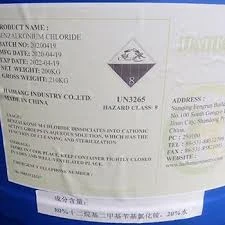Understanding the Uses and Safety of OIT Isothiazolinone in Modern Applications
Understanding OIT A Study of OIT and Its Applications
OIT, or octylisothiazolinone, is a synthetic compound that belongs to a class of chemicals known as isothiazolinones. These compounds are widely recognized for their effective biocidal properties, making them valuable in various applications, particularly in the preservation of products. The primary functions of OIT typically center around its roles as a biocide, fungicide, and preservative in a multitude of sectors including agriculture, cosmetics, and industrial products.
Chemical Properties and Mechanism of Action
OIT is characterized by its unique chemical structure, which allows it to disrupt the cellular processes of microorganisms. Its effectiveness stems from its ability to penetrate microbial cell membranes and inhibit essential metabolic functions. This makes OIT particularly effective against a variety of fungal and bacterial strains. The compound is typically used in low concentrations, which aids in reducing the risk of toxicity towards humans and the environment while still achieving significant microbial control.
The mode of action of OIT involves interference with microbial respiration and energy production, leading to cell death. This mechanism makes it an attractive alternative to traditional preservatives and antimicrobial agents, particularly in contexts where resistance might be a concern, such as in agricultural applications or product formulations.
Applications in Various Industries
1. Agriculture In the agricultural sector, OIT is utilized as a fungicide to protect crops from fungal infections. It helps in maintaining the health of plants, thus ensuring a better yield and quality of produce. By preventing fungal growth on fruits and vegetables, OIT contributes to reducing post-harvest losses, making it a valuable tool for farmers and agronomists.
2. Cosmetics and Personal Care Products OIT is frequently used in the formulation of personal care products, including shampoos, conditioners, and lotions. Its role as a preservative helps extend the shelf life of these products by preventing contamination from bacteria and fungi. This ensures that consumers receive safe and effective products free from microbial spoilage.
3. Industrial Applications In industrial settings, OIT is commonly incorporated into paints, coatings, and adhesives. Its antimicrobial properties help protect these products against degradation and spoilage, particularly in environments where moisture and heat can promote microbial growth. As a result, OIT plays a crucial role in enhancing the durability and effectiveness of industrial materials.
oit isothiazolinone

Safety and Environmental Considerations
While OIT is a powerful biocide, its use has also raised concerns regarding safety and environmental impact. In recent years, there has been growing scrutiny over the potential health effects of various isothiazolinones, including skin sensitization and allergic reactions. Regulatory bodies have begun implementing stricter guidelines and limits on the concentration of OIT in consumer products to mitigate these risks.
Furthermore, the environmental implications of using OIT are being examined. The compound has shown a potential for toxicity in aquatic environments, which raises questions regarding its long-term effects on ecosystems. As a result, researchers and manufacturers are exploring alternative preservatives and biocides that can provide similar effectiveness with reduced environmental impact.
Future Trends and Alternatives
In light of the challenges associated with OIT and similar compounds, the industry is increasingly focused on developing more sustainable and eco-friendly alternatives. This includes the exploration of natural preservatives derived from plant sources, which can offer antimicrobial properties without the associated risks of synthetic chemicals. In addition, biotechnological advancements may lead to the discovery of novel agents that can efficiently replace traditional isothiazolinones in various sectors.
Moreover, consumer demand for safer and more sustainable products is driving innovation in product formulations. As awareness of the potential risks associated with certain chemicals grows, manufacturers are under pressure to reassess their ingredient choices and seek efficacious yet safe alternatives.
Conclusion
OIT remains a valuable compound in various fields due to its excellent antimicrobial properties. However, the growing emphasis on safety, environmental sustainability, and consumer health calls for a careful evaluation of its use and potential alternatives. As research continues to evolve, the future of biocides like OIT may see significant transformations that align with holistic safety and environmental guidelines, ensuring a balanced approach to product preservation in an ever-evolving market.
-
Water Treatment with Flocculant Water TreatmentNewsJun.12,2025
-
Polymaleic AnhydrideNewsJun.12,2025
-
Polyaspartic AcidNewsJun.12,2025
-
Enhance Industrial Processes with IsothiazolinonesNewsJun.12,2025
-
Enhance Industrial Processes with PBTCA SolutionsNewsJun.12,2025
-
Dodecyldimethylbenzylammonium Chloride SolutionsNewsJun.12,2025





